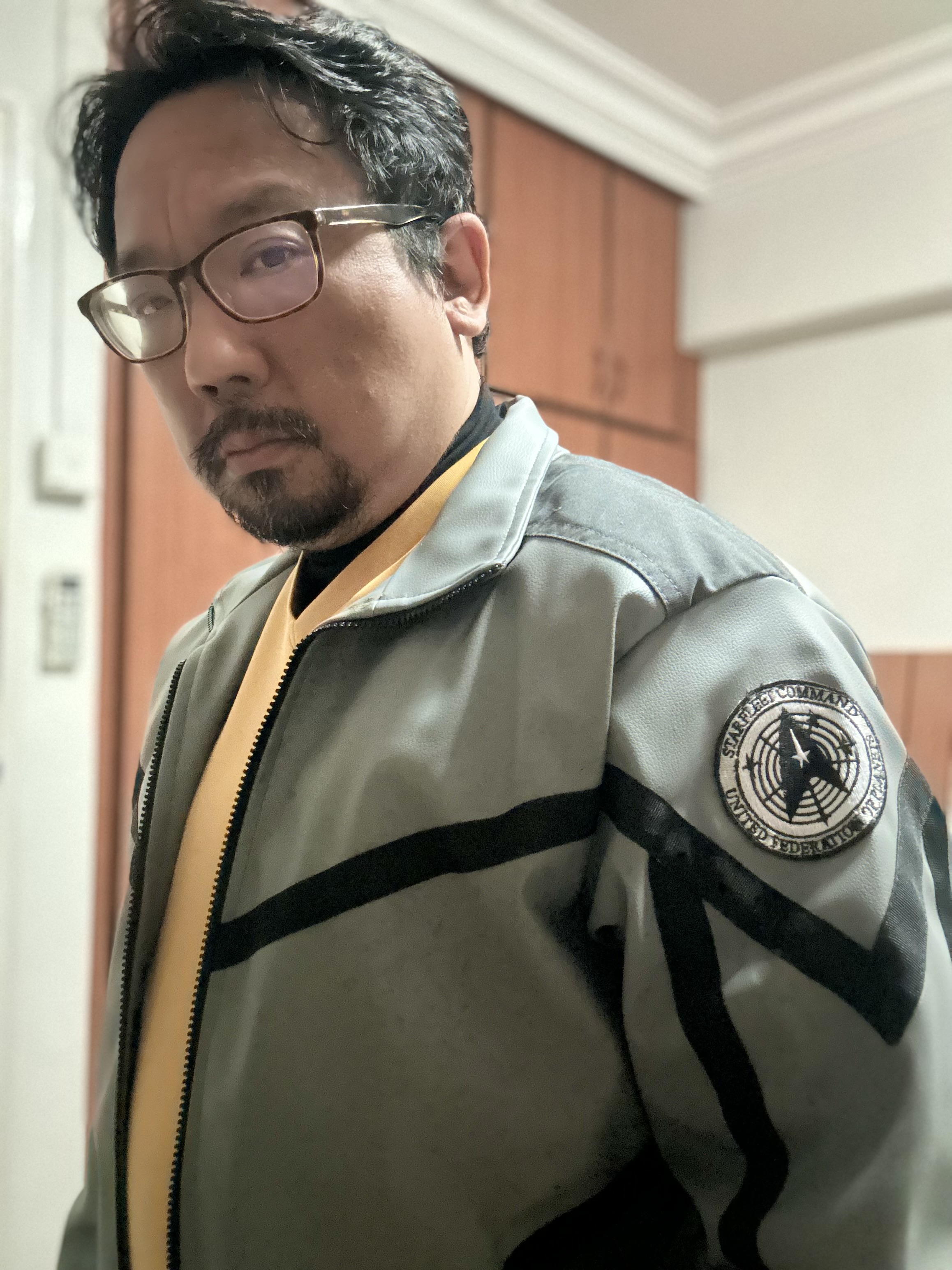The title alludes to old time radio plays, and modern reproductions such as the “Thrilling Adventure Hour”, which ran as a podcast and staged performances in Los Angeles from 2005 to 2015. It is also an episode where the cast play different characters, like SNW: “The Elysian Kingdom”.
The first music cue is from TOS, and of course the lighting, costuming and props all evoke the style of TOS and 1960s science fiction. The wave-form on the large screen reminds me of the Control wave from the title sequence of The Outer Limits.
“Maxwell Saint” is sitting in a very typical James Kirk pose in the chair and speaks in a parody of William Shatner’s acting and diction. “Lee Woods” mentions the war - Ortegas served in the Klingon War. Zipnop of the Triathic Agonyan Empire has very visible wire rods holding up their “eyes”. The face also reminds me of the aliens in the 1957 movie Invasion of the Saucer Men.
The title sequence has been altered to resemble TOS’s opening narration and titles. For what it’s worth, 84 months is 7 years, alluding to the 7 seasons given TNG, DS9 and VOY. The USS Adventure has a registry number of 20-1. The title The Last Frontier riffs off Trek’s “final frontier” line.
We’ve seen holographic battle simulators in DIS: “Lethe”, and Enterprise had a recreation or rec room in TAS: “The Practical Joker” , so the concept of a holodeck predates TNG by quite a bit, although the model first seen in TNG: “Encounter at Farpoint” was supposed to be the latest model and both Riker and Wesley seemed impressed by it. The screen in the briefing room displays the “Holodeck Program Power Distribution”. In VOY: “Parallax” it was said that holodecks run off holodeck reactors which are incompatible with standard power systems on the rest of the ship.
Spock took dance lessons from La’An in SNW: “Wedding Bell Blues” and is continuing them in lieu of his morning calisthenics routine. Much like Picard enjoyed Dixon Hill stories from the 1930s, La’An enjoys Amelia Moon mysteries from the 1960s. Using transporter buffer patterns to create holographic avatars is similar to what happened in DS9: “Our Man Bashir”.
La’An’s request for a mystery that is challenging to solve is at least less foolhardy than Geordie’s request for an adversary capable of defeating Data (TNG: “Elementary, Dear Data”). The grid pattern of this 23rd Century holodeck is the same as those in 24th Century holodecks. La’An even gives the standard “run program” command.
Spock alluded to his ancestor being Conan Doyle (or as some speculated, Sherlock Holmes) in ST VI when he quoted the aphorism that “when you eliminate the impossible, whatever remains, however improbable, must be the truth.” This confirms it. In the real world, none of Doyle’s children had offspring, so Spock can’t be a direct descendant.
La’An - I mean, Amelia Moon switches into an American accent when speaking to Uhura - I mean, Joni Gloss. The voice-over narration alludes to that in classic noir films and hard-boiled detective stories.
Amelia refers to Gloss, a Hollywood agent, as “William Morris” - the William Morris Agency represented some of the biggest names in Hollywood history.
Max Factor does have a Ruby Red shade, but it was released in 2015 and inspired by Marilyn Monroe.
The Sunny Lupino character, with allusions to an ex-husband and relationships with the studio, not to mention the red hair, has characteristics of comedienne Lucille Ball, her ex-husband Desi Arnaz, and Desilu Studios’ involvement with the production of Star Trek. Her reference to Alfred (Hitchcock) putting her in Crows (1963’s The Birds) also references Tippi Hedren, who Hitchcock discovered and gave her first leading role. Hedren didn’t win an Oscar for that, however. Her name also echoes film star Ida Lupino.
Woods’ remark, “I’m an actor, not a doctor,” is an inversion of Dr McCoy’s catchphrase, “I’m a doctor, not a…”
Having a lead detective’s partner be a “bumbling idiot” is akin to the stereotype of Watson being bumbling next to Holmes, thanks to Nigel Bruce’s portrayal of him in the Basil Rathbone films. In the stories, however, Watson was not at all bumbling, but merely appeared less intelligent because he served as an audience surrogate for Holmes to explain his amazing deductions.
The NPCs notice Spock’s uniform, much like Trixie did when Picard walked into the Dixon Hill simulation in TNG: “The Big Goodbye”.
Ortegas’ suspension for insubordination was in SNW: “Shuttle to Kenfori”.
Omnidirectional holodiodes are a primary component of holodecks, first mentioned in the Star Trek: The Next Generation Technical Manual but never on-screen until now.
Jess Bush uses her natural Australian accent as Adelaide Shaw (Adelaide is a city in South Australia). Hedda Gabler is an 1891 play by Henrik Ibsen. The West End refers to London’s theatre district.
The lack of safeties and the inability to end the program is a long-honoured Trek trope that has finally made its way to SNW.
“You know what’s not realistic? A lady first officer.” Roddenberry always claimed that the reason Number One (Majel Barrett) had to be replaced was because the network didn’t want a woman in a command position. It may be truer that they didn’t want Roddenberry’s mistress to be one of the leads of the new show.
“Mick Bowie” may be a real character in this world, or Saint just mocking McBeau with a portmanteau of Mick Jagger and David Bowie.
Gloss’s very meta description of what Bellows wanted to do with The Last Frontier is what Roddenberry wanted to do with Star Trek.
Scotty’s suggestion provides an explanation why holodecks have their own dedicated power sources and processors. Pike’s Enterprise having a crew of 203 was first mentioned in TOS: “The Cage”.
The end credits are printed in the style of TOS (as is the music), but instead of still photographs we have bloopers, including “space acting” (what the actors call the moving from side to side as if the ship is being shaken about) and Saint trying to get in the chair using the Riker Maneuver.

